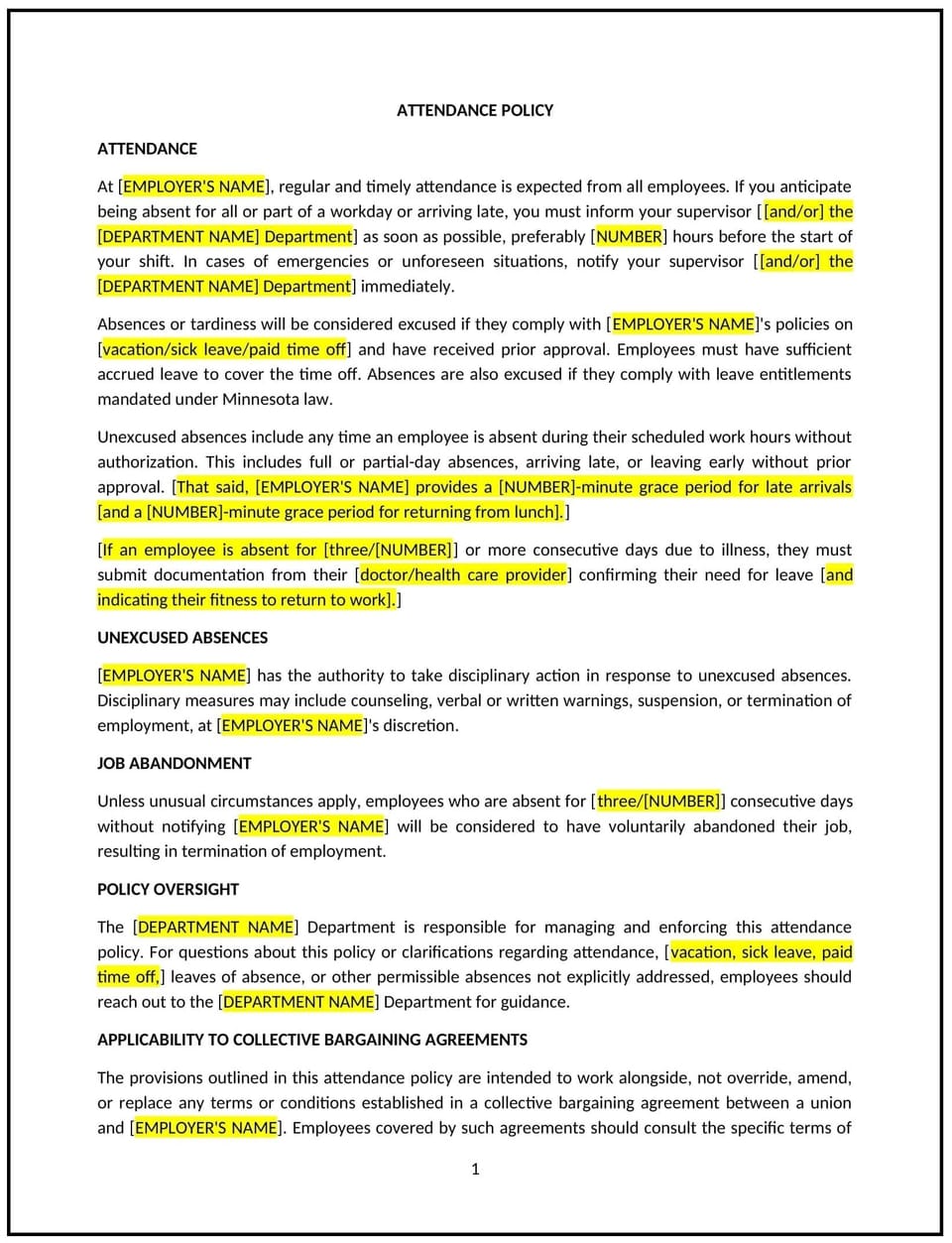Attendance policy (Minnesota): Free template

Attendance policy (Minnesota)
This attendance policy is designed to help Minnesota businesses establish clear expectations for employee attendance and punctuality. Whether businesses are managing remote teams, in-office staff, or hybrid work environments, this policy provides a framework to promote reliability and productivity. Tailored to Minnesota’s workforce dynamics, this policy emphasizes fairness, communication, and consistency in addressing attendance-related issues.
By implementing this policy, businesses in Minnesota can maintain operational efficiency, reduce disruptions, and foster a culture of accountability and professionalism.
How to use this attendance policy (Minnesota)
- Define attendance expectations: Clearly outline the business’s expectations for punctuality, regular attendance, and communication regarding absences or tardiness.
- Establish reporting procedures: Provide employees with clear guidelines for reporting absences, requesting time off, or notifying supervisors of delays.
- Address remote and hybrid work: Include specific guidelines for attendance and availability in remote or hybrid work arrangements.
- Set consequences for non-compliance: Outline the steps the business will take to address repeated attendance issues, such as verbal warnings, written notices, or further disciplinary action.
- Encourage open communication: Foster a culture where employees feel comfortable discussing attendance challenges or requesting accommodations.
- Review and update the policy: Regularly assess the policy’s effectiveness and make adjustments as needed to reflect changes in work arrangements, employee needs, or business operations.
- Communicate the policy: Share the policy with employees during onboarding and through regular reminders, such as emails or team meetings.
Benefits of using this attendance policy (Minnesota)
This policy offers several advantages for Minnesota businesses:
- Promotes reliability: Clear attendance expectations help ensure employees are present and punctual, reducing disruptions to workflow.
- Enhances productivity: Consistent attendance supports team collaboration and timely completion of tasks and projects.
- Reduces administrative burden: A structured policy simplifies the process of managing attendance records and addressing issues.
- Encourages accountability: Employees are more likely to take responsibility for their attendance when expectations are clearly defined.
- Supports flexibility: The policy can accommodate remote, hybrid, and in-office work arrangements, reflecting modern workplace trends.
- Improves communication: Clear guidelines for reporting absences or delays foster transparency and trust between employees and management.
- Aligns with business goals: A reliable workforce contributes to the overall success and efficiency of the business.
Tips for using this attendance policy (Minnesota)
- Communicate the policy effectively: Share the policy with employees during onboarding and through regular training sessions.
- Provide flexibility where possible: Consider offering flexible work hours or remote options to accommodate employee needs while maintaining productivity.
- Address attendance issues promptly: Use a progressive approach to address repeated attendance problems, starting with informal discussions and escalating as needed.
- Be consistent: Apply the policy fairly and consistently to all employees to avoid perceptions of favoritism or bias.
- Encourage feedback: Regularly seek input from employees on how the policy can be improved to better meet their needs and the business’s goals.
- Review the policy periodically: Update the policy as needed to reflect changes in work arrangements, employee needs, or business operations.
Q: Why should Minnesota businesses adopt an attendance policy?
A: Businesses should adopt this policy to set clear expectations for attendance, reduce disruptions, and maintain productivity.
Q: What should businesses include in an attendance policy?
A: Businesses should outline expectations for punctuality, procedures for reporting absences, and consequences for non-compliance.
Q: How should businesses handle repeated attendance issues?
A: Businesses should address attendance issues promptly, using a progressive approach that includes verbal warnings, written notices, and further disciplinary action if necessary.
Q: How can businesses accommodate remote or hybrid work arrangements in the policy?
A: Businesses should include specific guidelines for attendance and availability in remote or hybrid work environments, ensuring clarity and consistency.
Q: What steps should businesses take to communicate the policy effectively?
A: Businesses should share the policy during onboarding, provide regular reminders, and encourage open communication about attendance expectations.
Q: How often should the policy be reviewed?
A: The policy should be reviewed annually or as needed to reflect changes in work arrangements, employee needs, or business operations.
Q: What role do managers play in enforcing this policy?
A: Managers should lead by example, address attendance issues promptly, and ensure all employees understand and adhere to the policy.
This article contains general legal information and does not contain legal advice. Cobrief is not a law firm or a substitute for an attorney or law firm. The law is complex and changes often. For legal advice, please ask a lawyer.


